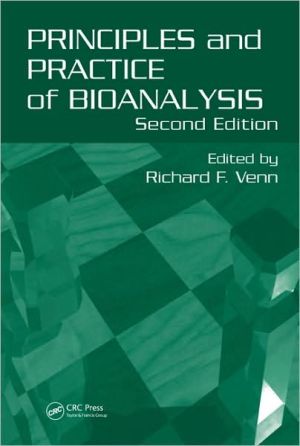Priniciples and Practice of Bioanalysis
In the seven years since the publication of Principles and Practice of Bioanalysis bioanalytical methods have remained the same, but their usage patterns have changed. This second edition of a bestseller provides an updated guide to the techniques used in developing and running ultra-trace analyses for drugs, metabolites, and other substances.\ Extensively revised, this volume reflects the dynamic growth in methodologies that has occurred over the past five years. Each chapter has been...
Search in google:
In the seven years since the publication of Principles and Practice of Bioanalysis bioanalytical methods have remained the same, but their usage patterns have changed. This second edition of a bestseller provides an updated guide to the techniques used in developing and running ultra-trace analyses for drugs, metabolites, and other substances. Extensively revised, this volume reflects the dynamic growth in methodologies that has occurred over the past five years. Each chapter has been overhauled or re-written to reflect modern practice. Experts in the field offer a logical path through the problems of small molecule bioanalysis, enabling you to choose the appropriate methods of analysis across a number of fields, including the agrochemical and pharmaceutical industries. They cover a wide range of analytical methods, including mass spectrometry, liquid chromatography, immunoassay, NMR, and gas chromatography. Presenting the information in an informal and highly accessible style, the book covers the theory and practice of bioanalysis, enabling you to gain maximum benefit and to optimize analytical methods. With practical advice and guidance, it delineates how to develop robust analytical methods for a range of compounds, both natural and synthetic. Using these insights, you can more easily recognize problems and quickly solve them.
Preface to the Second Edition viiPreface to the First Edition ixAbout the Editor xiContributors xiiiPhysicochemical Properties of Drugs and Metabolites and Their Impact on Bioanalysis Hugh Wiltshire Angus Nedderman 1Sample Preparation Christopher A. James 19Basic HPLC Theory and Practice Andy Gray Peter Lawrence 41HPLC Optimisation David Bakes 69HPLC Detectors Kenneth C. Saunders Richard F. Venn 99Gas Chromatography: What It Is and How We Use It Peter Andrew Mira V. Doig 123Thin-Layer Chromatography Hugh Wiltshire Angus Nedderman 141Immunoassay Techniques Richard F. Venn 151Automation of Sample Preparation Kenneth C. Saunders Christopher A. James 177Fundamental Aspects of Mass Spectrometry Mira V. Doig David M. Higton 193Quantitative LC-MS David M. Higton Mira V. Doig 223Mass Spectrometric Identification of Metabolites Gordon Dear 237Nuclear Magnetic Resonance in Drug Metabolism Phil Gilbert 261Metabolite Isolation Gordon Dear Angus Nedderman Hugh Wiltshire 285Strategy for the Development of Quantitative Bioanalytical Procedures David Bakes 303Index 317
\ From The CriticsReviewer:Eugene A Davidson, PhD(Georgetown University School of Medicine)\ Description:This is an introduction to practical, analytical methods used in the pharmacology industry.\ Purpose:This book is intended to serve as a text for a course in analysis developed by the pharmaceutical industry. This goal is well reflected in the nature of the material covered and the emphases. \ Audience:Students needing an appreciation of the analytical challenges faced by pharmaceutical manufacturing will profit from this text.\ Features:An introductory chapter covers a set of drugs and their metabolites - the focus is mainly on ionization and solubility properties and does not cover modes of drug metabolism. Examples are provided but the relationship of chemical or physical properties to a given separation or analytical method is missing. A detailed discussion of HPLC follows that includes theory and detectors. Similar coverage of thin layer and gas-liquid chromatography and capillary electrophoresis completes the discussion of separation methods. The remainder is devoted to analytical methods, including immunoassays, mass spectrometry and NMR. Since no protocols are included, it can be assumed that the companion course does not include practical exercises. \ Assessment:It should be realized that for most of the technologies discussed, only superficial treatment is provided. Conversely, if one needs mass spectral data in an industrial setting, the company will have experts available for that purpose.\ \ \ \ \ BooknewsMostly British scientists working mostly in industry laboratories explain the methods and strategies for developing and running ultra- trace analysis for drugs, metabolites, and other substances. Rather than recipe-type guides, they describe the basics and strengths and weaknesses of such techniques as solid-phase extraction, high- performance liquid chromatography optimization, capillary electrophoresis, and immunoassays. Most of the examples are from the pharmaceutical industry, but the principles should apply to analyzing small molecules in a biomatrix in such fields as biochemistry and environmental monitoring as well. Annotation c. Book News, Inc., Portland, OR (booknews.com)\ \ \ 2 Stars from Doody\ \








